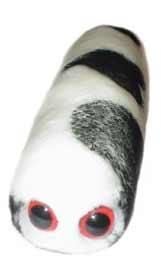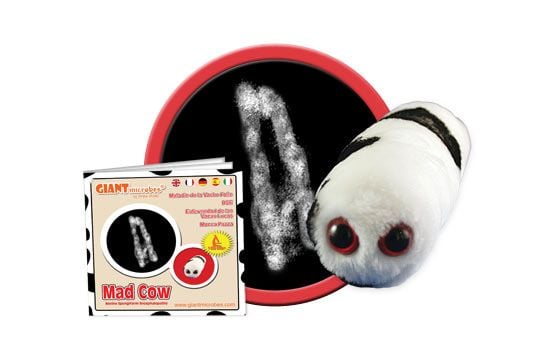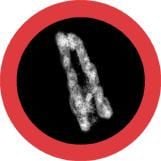Mad Cow (Bovine Spongiform Encephalopathy)
When bovine prions stampede the wrong way, everyone says Moo! Memorable plush representation of Mad Cow disease is the perfect gift for friends, family, educators, scientists, public health professionals, veterinarians, and anyone with a healthy sense of humor.
GIANTmicrobes Mad Cow provides a fun hands-on way to learn about protein prions and how this neurodegenerative disease destroys the nervous system. Features detailed stitching, high quality materials and includes an educational printed card with fascinating facts about this disease.
Size: 20 x 5 x 4cm
Product Details
Additional Information
| Sizes | Giantmicrobes are based on actual microbes, cells, organisms and other critters, only 1,000,000 times actual size! Gigantic (GG) 40-60cm XL (XL) 25-38cm Original (PD) 12-20cm Minis (MM) 5-10cm each Keychain (KC) 5-10cm with clip |
|---|---|
| Materials | Plush from all new materials. Stuffed with polyester fiber fill. Surface washable: sponge with water & soap, air dry. |
| Packaging | Each plush microbe includes a printed card with fun, educational and fascinating facts about the actual microbe or cell. |
| Safety | Every product meets or exceeds U.S. and European standards for safety. For ages 3 and up. |
All about Mad Cow (Bovine Spongiform Encephalopathy)
FACTS: First identified in Britain in the mid-1980's, Mad Cow disease, or Bovine Spongiform Encephalopathy (BSE), is generally thought to be the work of proteinaceous infectious particles, or prions. These inanimate amino acid chains (which are far smaller than bacteria or viruses, and are not destroyed by thorough cooking) normally twist like pretzels into a particular shape. According to theory, they can get a little crazy and twist the wrong way. Similar proteins follow the herd, go nuts as well, and congeal into long rods that ultimately inhibit brain function. (Other prion diseases include the sheep-disease scrapie; Kuru, once found in the cannibals of Papua-New Guinea; and Creutzfeldt-Jakob disease, a variant of which is believed to be Mad Cow in humans.)
Although Mad Cow prions are typically found in brains and spinal tissues, and are thought to be transmissible primarily by direct consumption, even cows and humans without a predilection for consuming nervous tissues are at risk: at processing plants, these materials can end up both in cattle feed and on your sirloin steak. (In fact, cattle feed contaminated with scrapie-infected sheep tissue is credited with spreading ovine prions into the bovine population.)
With an up-to-decades-long latency period, no cure, no treatment, and no chance of recovery, concern about BSE is no bull. Nevertheless, the risk of infection is extremely low. Strenuous efforts are being made to prevent the spread of Mad Cow, including the implementation of strict animal feed regulations and processing standards. So beef-eaters are hardly insane to keep eating – though that may make cows even madder....
| Name | Bovine Spongiform Encephalopathy (BSE) |
|---|
| Actual Size | The protein prion, the cause of this disease, is about 33 nm in diameter |
|---|
| Where It Lives | The disease originates in an abnormal protein located on the surface of cells found in the brain, spinal cords, or small intestines. |
|---|
| System | Attacks the central nervous system. |
|---|
| Commonality |
There have only been four confirmed cases in the USA. From 1986 to 2001, a British outbreak affected 180,000 cattle but was contained well. |
|---|
| Symptoms | Incoordination, difficulty walking or standing up, and acting nervous or violent (emphasis on the mad portion of the name Mad Cow Disease). |
|---|
| Cure | There is currently no cure or vaccination for this disease. |
|---|
| Deadliness/Severity | There have been no cases of an animal surviving this illness. |
|---|
| Infectiousness |
The illness only spreads if a cow that died of Mad Cow Disease is fed to other cattle. Before the disease was researched, enormous outbreaks occurred from single cow. Nowadays, it is very easy to contain once identified. Incubation period is anywhere between four and six years. |
|---|
| History |
In the 1980‘s The University of California discovered that samples of the infected cows had BSE The first documented outbreaks of the disease occurred in the United Kingdom in 1986 “Bovine” means that the disease affects cows, “Spongiform” references the spongy texture of an infected brain, and “Encephalopathy” indicates that it is a disease of the brain. Big Outbreaks: In 1988, 421 cows were diagnosed, by 1993, 120,000 cattle were diagnosed. |
|---|
| Fascinating Facts |
Humans cannot contract BSE, but a vCJD from consuming infected beef Thoroughly cooking meat will not disinfect it Both cows and humans will not know they are infected until years later. When they start showing symptoms, death generally occurs within two weeks to six months. In Culture: In the film We Are What We Are, a family member succumbs to the human form of the disease Discussed on Oprah on April 15th, 1996 |
|---|






